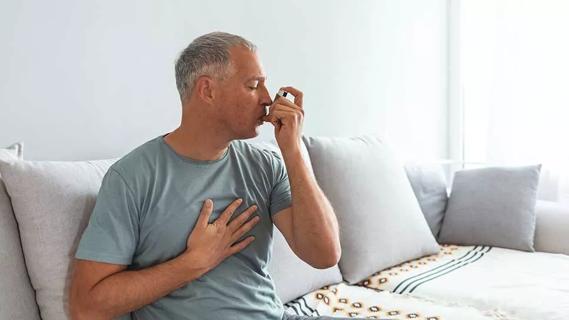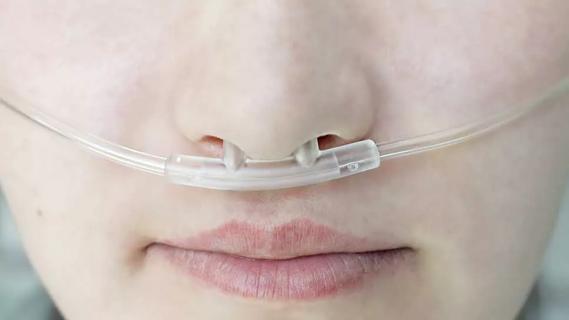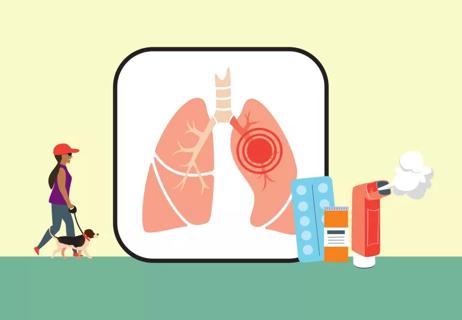Diaphragmatic breathing, pursed lip breathing and huff coughing can help manage COPD symptoms, like chest congestion and shortness of breath

If you’re living with chronic obstructive pulmonary disease (COPD), the “simple” act of breathing can become a source of frustration, fear and fatigue.
Advertisement
Cleveland Clinic is a non-profit academic medical center. Advertising on our site helps support our mission. We do not endorse non-Cleveland Clinic products or services. Policy
Incorporating COPD breathing exercises into your daily life can help.
Respiratory therapist Scott Marlow, RRT, AE-C, shares three foundational breathing exercises for COPD symptom relief.
Breathing exercises are an important part of a COPD self-care regimen because the disease causes air and mucus to get trapped in your lungs. Intentionally working out your respiratory system every day can make clearing the stale air and mucus a little easier.
“If you do breathing exercises regularly, it may ease everyday symptoms,” says Marlow. Symptoms may include:
“These exercises can make breathing more efficient, less exhausting and improve your daily life,” he adds.
There are lots of breathing techniques out there that can help you relax and improve your COPD symptoms. You’ll work with your pulmonologist or your respiratory therapist to decide which are safest and most effective for you.
There are three specific exercises that pretty much everyone — including those without breathing problems — can benefit from trying.
Diaphragmatic breathing can improve your ability to take full breaths, without putting added strain on your chest muscles or worsening COPD symptoms.
Advertisement
“Over the years, people with COPD tend to use extra muscles in their chest to make up for a weak diaphragm,” Marlow reports. “Diaphragmatic breathing can help you breathe more efficiently and relieve shortness of breath and chest tightness.”
Here’s a fun bonus: It’s also relaxing!
“If you ever watch a baby breathe, you'll see their bellies moving up and down,” he illustrates. “That’s diaphragmatic breathing.”
Follow their lead with these simple steps:
If you find diaphragmatic breathing difficult, try doing it reclining or lying down. That way, you aren’t fighting gravity to take a deep breath.
Pursed lip breathing opens up some of the smaller airways in your lungs, allowing you to empty them more completely. It’s also helpful if you experience shortness of breath in the middle of a physical activity, like walking or cleaning the house.
“When you get short of breath, you start to breathe faster because you’re working a little harder,” Marlow explains. “Pursed lip breathing creates pressure that allows your airway to stay open longer and your lungs to empty more completely.”
To perform this exercise:
“I’m a big fan of pursed lip breathing,” Marlow shares. “If you practice it routinely, it can really help ease COPD symptoms.”
Huff coughing is a coughing technique that gently breaks up mucus and other secretions that build up in your lungs when you have COPD. It’s also gentle and shouldn’t cause the kind of irritation that a coughing fit does.
“It’s part of an airway clearance routine,” Marlow explains. “The idea is not to wear yourself out coughing.”
Don’t like how coughing up mucus feels? You’re not alone! But if you have COPD, it’s important to do it anyway. If those secretions build up, they can block your airway and raise your risk of infection.
To complete a huff cough:
Advertisement
Any time is a good time to practice COPD breathing exercises. They’re also worth doing when your symptoms are flaring up.
Marlow recommends practicing:
COPD breathing exercises can’t cure your condition. Think of them the same way you think about staying active. It’s a management technique that, done daily, can make it easier to cope with unpleasant symptoms.
“We’re just trying to make your breathing a little more efficient, trying to make your life a little better long-term,” Marlow emphasizes.
Making COPD breathing exercises a part of your daily routine doesn’t just improve your lung health — it can also help you spot exacerbations and flare-ups early. Contact your provider if:
Advertisement
COPD flare-ups and exacerbations can be scary, but your healthcare team can support you through them. With their guidance and care, you can better manage your symptoms and improve your quality of life.
Advertisement
Learn more about our editorial process.
Advertisement

A change in diet won’t cure COPD — but getting to or maintaining a healthy weight will help

Both conditions have similar symptoms, but different causes and treatments

You can reduce your chances of a flare-up by quitting smoking, avoiding respiratory infections and following your doctor’s orders

Get improved quality of life and breathe better

Quitting smoking helps immediately, but this disease doesn’t only affect people who smoke

Adult-onset asthma has the same symptoms as childhood asthma, but tends to be more severe

An asthma action plan is a personalized, step-by-step set of instructions for handling asthma attacks

There’s no safe way to find, handle, repair or remove asbestos yourself — it’s always a job for a professional

The best parenting style balances enforcing rules and showing plenty of love

Tips include cutting back on sugar, focusing on exercise and managing stress

It can be harder to let go when you’ve invested time, energy and emotions — but it might be the healthier choice long term